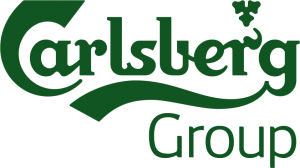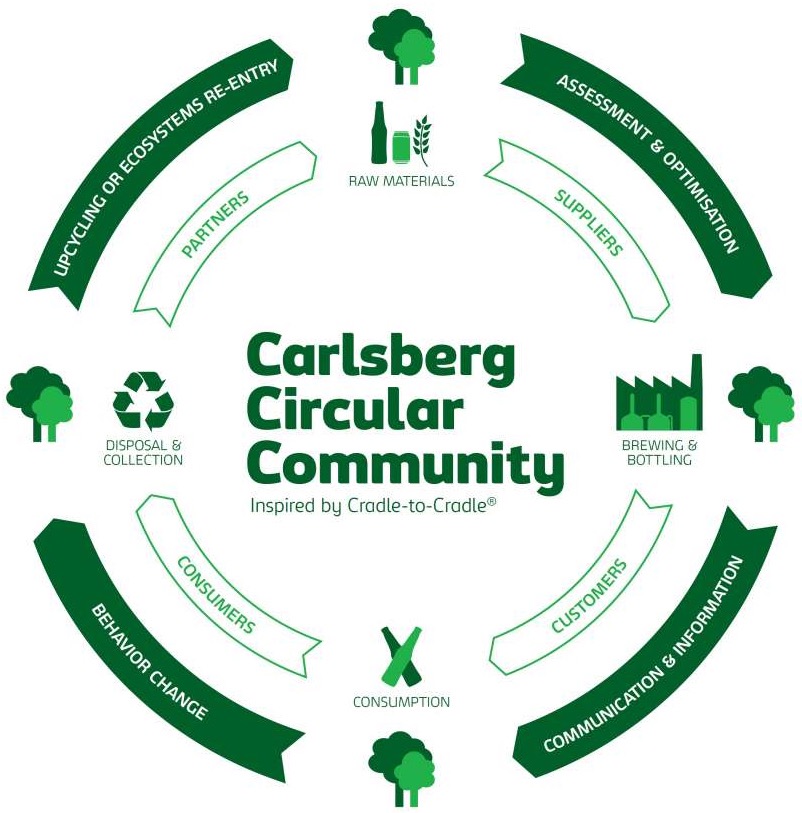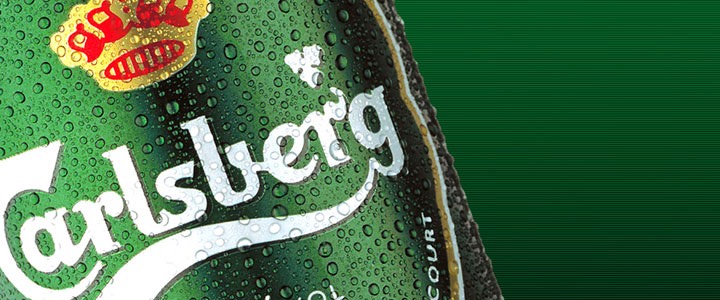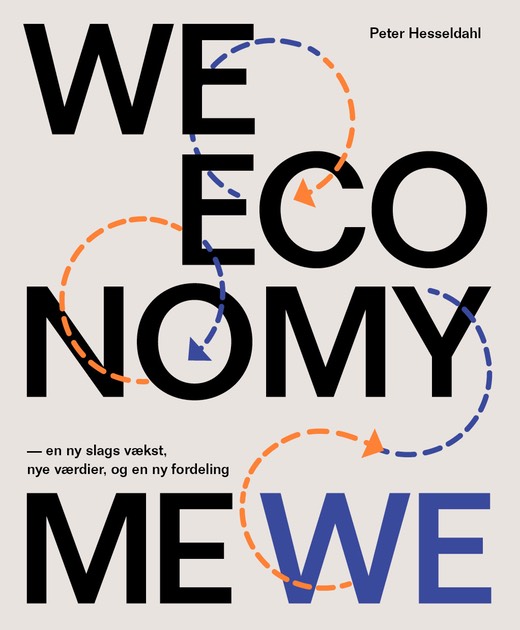For the Danish brewery Group Carlsberg recycling and minimizing the use of packaging will be increasingly important as resources become scarcer and the price of raw materials goes up. However, even a global giant like Carlsberg cannot do it alone.

Carlsberg sells approx. 36 billion bottles of beer and soft drinks annually, and the packaging ? such as glass or plastic bottles, aluminum cans, kegs, shrink-wrap, card board boxes and crates ? represents about 45% of the company?s total CO2 emissions. This alone poses a good reason for the company to focus on this area. However, an increasing regulatory pressure to reduce waste and increase recycling is also inspiring the company to take a proactive stance on the topic.
In short, the company realized that in order to sell consumer-relevant as well as reasonably priced products in the future, it needed to focus on making its packaging more sustainable, by embracing the circular economy, and rethinking its approach to its packaging materials.
To this end, the company established the Carlsberg Circular Community, a collaboration platform, where Carlsberg cooperates with different partners to optimize packaging materials for reuse and recycling, in order to preserve the value of the materials. Initially, 6 suppliers have joined the initiative on a global level, while other partners are engaged on a local level, such as the retailer Tesco, who is working with Carlsberg in Poland to increase awareness of recycling.
You can?t be a circular business alone
The ?Cradle-to-cradle? design framework is the philosophy behind the project. This implies viewing packaging as something that should be optimized for either the biological or technical cycles, and thereby reenter either cycle as resources in endless loops.
To achieve this, the Carlsberg circular community looks at four phases in the use of packaging ? and each of these require a close cooperation between the brewery and the stakeholders involved in producing, selling and consuming the beer.
As Anne-Marie Skov, Senior Vice President of Corporate Affairs says: ?We cannot do this alone. We need partners and knowledge sharing to find the future solutions to reduce our reliance on primary materials?

Phase 1: Optimizing the input
The first stage is to examine the input of raw materials. Carlsberg has engaged German scientific authority, EPEA, for conducting chemical analysis, which is led by Michael Braungart, one of the original founders of the Cradle-to-Cradle movement. EPEA analyses the material composition of the packaging down to 100 parts pr. million in order to identify materials that are harmful or might become problematic at a later stage, when the materials are supposed to be reused. The suppliers then work to replace or simply remove those materials.
Simon Hoffmeyer Boas, who is heading up the work on sustainable packaging in the Carlsberg Group notes that ?by optimizing the materials at an early stage you avoid substances, that can reduce of the materials at the later stage?.
Phase 2: Engaging retailers
Some of Carlsberg?s most important customers are the retailers, such as the large super markets. In some countries, like Scandinavia and Germany, there are well established systems for collecting used bottles and cans. In other countries, however, there?s practically no infrastructure for recycling.
In Russia, one of Carlsberg?s? largest markets, only 4% of waste is recycled For this reason Carlsberg is working on creating a waste infrastructure, by selling refillable glass bottles and engaging with partners who can make sure that the bottles are collected and brought back to the brewery for refilling.
Phase 3: Engaging consumers
Consumers need to be engaged as well, and the challenge here is to change culture and behavior. In Poland, with the large retailer Tesco, Carlsberg arranges annual collection campaigns in which consumers are encouraged to bring back their used packaging, and are given little gifts or value points for shopping in return.
Carlsberg also regularly campaigns at large music festivals to try to change the consumers? attitude to recycling. For this, Carlsberg has cooperated with the aluminum Industry through the initiative ?Every Can Counts?, in order to create infrastructure and image campaigns, encouraging consumers to return used cans.
As Simon Hoffmeyer Boas says: ?If you want to teach young people to hand in their packaging rather than throwing it in the trash, you need to make it fun, by introducing games and competitions. Furthermore, it has to be easy to ?do the right thing?. We are not going to change their behavior by preaching and throwing ?recycling facts? at them?.
Phase 4: End of life
Finally, when the used packaging has been collected, the materials need to be either re-used or what?s called ?up-cycled?. Up-cycling means converting a used material into a product of the same or higher value ? for instance using recycled aluminum to create a new can.
Simon Hoffmeyer Boas explains that the goal is to find the highest value use for the materials. In the case of glass bottles, they can be cleaned and re-used up to 40 times, and as long as the bottle is still useable, that is an optimal way to re-use the materials. In the case of aluminum, it can be re-used as cans, but it could also be used as raw materials for bicycles or for a component in a bridge or other building materials. An important aspect is that the materials can be recovered again after use.
Finding the best value requires that Carlsberg work with companies that are able to use the old packaging ? even if those companies are in sectors that normally have no connection to a brewery.

A community ? but all are not equal
The recycling project is a community in the sense, that it is a collaboration among a group of companies, that have a shared interest in raising the return rates of package, and which are not able to change it alone. However, in this case, it?s clearly driven by the largest participant. It?s no co-incidence that it?s called the Carlsberg circular community.
Carlsberg has chosen the partners, and Carlsberg pays EPEA to analyze the materials. Simon Hoffmeyer Boas is very positively surprised how willing the suppliers have been to cooperate.
He stresses that the process is founded on conversation and collaboration:
?We are not dictating what the suppliers should do, and we?re not threatening to stop buying from them unless they follow the suggestions. It?s a partnership, and our partners should be able to see the value for themselves in the changes they make?.
In-direct benefits
For Carlsberg, the benefits of the circular community are mainly long-term. The suppliers can benefit if they replace a harmful and costly material with one that?s more benign and cheaper. Furthermore, by modifying the materials, the suppliers make their products more competitive. It?s more likely in the coming years that it will be bought by Carlsberg ? as well as by other customers.
Likewise, if the materials become better suited for recycling and their value goes up, this doesn?t directly benefit Carlsberg (apart from perhaps in Denmark, where Carlsberg is co-owner of the national recovery system for beer and beverage products ? Dansk Retur System).
You have to accept that this is a project with a longer pay back, says Simon Hoffmeyer Boas: ?For Carlsberg it is also part of a recognition that there are more measures of success in business than money. A strong brand, new ways of engaging consumers, and creating a visionary change in the world have value in and of themselves?.
Even so, Hoffmeyer Boas maintains that the primary reason for Carlsberg to drive the circular community is that the company?s management believes it will strengthen business in the long-term: ?We?re convinced that if we did not do this, we would sell a lot less beer in 5-10 years, because our costs would much higher due to increasing input prices and regulation?.
Conclusions
In order to do business in a circular way, you need to connect, to suppliers, customer, and consumers ? and even to companies in completely different business sectors.
The benefits of creating a value chain, which is more sustainable and based on sustainable materials, are long term and the benefits of ones? investments can be both tangible (through lower prices) and intangible (through better image).
Although such project is primarily driven in order to keep making profits, other values such as brand, consumer relations and being a good corporate citizen are also part of the equation.
The issues that Carlsberg and its partners are working on are in principle the same in other industries. Any industrial product has a complex value chain, and currently, it is typically linear in the sense that it consumes raw materials to produce objects that are ultimately discarded. Closing the loop in the material stream requires cooperation among all stakeholders along the value chain.
Although Carlsberg?s core business is to produce and sell beverages, in order to do so on a global scale and in an economy with greater scarcity of resources, the company needs to optimize and organize the entire lifecycle of the product, from cradle to cradle.
